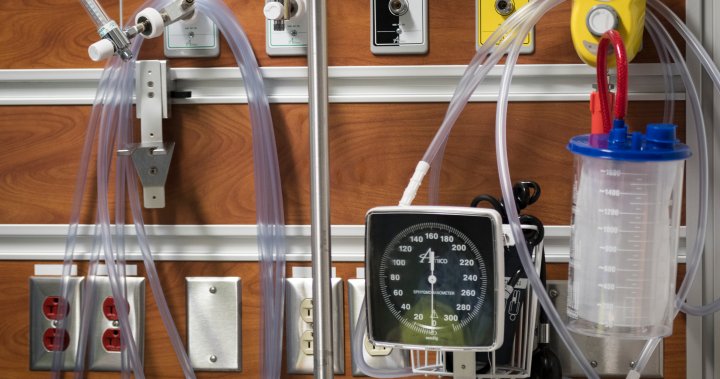Canada’s pharmacare bill is now law. What this means for you – National

[ad_1]
Canada’s pharmacare bill has officially become a reality after it officially passed through the Senate Thursday and received royal assent.
That means many will soon have access to more medications, including those for diabetes and contraception, which are deemed essential and can cost hundreds or thousands out of pocket each year, though specific provincial agreements are still in negotiation.
The legislation, part of the now-defunct political agreement between the Liberals and the NDP, establishes a framework for the creation of any future universal pharmacare plan.
“Today is about pharmacare. It is an incredibly important day for this country,” Health Minister Mark Holland said during a Friday media briefing. “I am not going to say this was easy…. Getting this bill adopted through the House and the Senate was incredibly difficult.”
Now that Bill C-64 is law, the pharmacare plan will provide coverage for certain diabetes treatments and contraception in provinces that reach agreements with the federal government.
These agreements will support reproductive freedom by providing up to nine million women and gender diverse people in Canada free access to contraception, Holland says.
Additionally, the 3.7 million people in Canada living with diabetes will have universal access to a suite of medications that reduce the risk of serious health complications and improve quality of life, the government said.
Here’s what you need to know about the bill.

The pharmacare legislation includes universal access to contraception and diabetes medications, with the goal to expand the number of covered medications in the future.
It also implements a universal first-dollar coverage pharmacare plan for medications, meaning that the government pays the costs upfront.
The diabetes medications covered include first-line treatments that lower blood glucose levels, providing Canadians with access to essential therapies such as:
- Insulin, which is used by patients with Type 1 and Type 2 diabetes.
- Metformin, which is used by patients with Type 2 diabetes.
- Medications often used in combination with insulin and metformin by patients with Type 2 diabetes, including sulfonylureas and SGLT-2 inhibitors.

Get weekly health news
Receive the latest medical news and health information delivered to you every Sunday.
You can find a full list of the covered diabetes medication on the government of Canada’s website.
The bill also covers access to contraceptives for roughly nine million Canadians of reproductive age.
“Contraceptive drugs were chosen as part of this next step of universal pharmacare specifically because improved access to contraception improves equality. It reduces the risk of unintended pregnancies and improves reproductive rights,” Health Canada stated in a February media release.
The contraception coverage includes oral contraceptives, copper and hormonal IUDs, injections, implants, rings and morning-after pills.
Find a full list of the covered contraceptive medication on the government of Canada’s website.
Will provinces and territories sign on?
Now that the bill has become law, Prime Minister Justin Trudeau urged provinces and territories to begin negotiating pharmacare deals as soon as possible. This includes payment and distribution
This is essential for implementing the plan, as the federal government must negotiate and sign agreements with the provinces and territories across the country.
“This is real progress, but now we need the provinces and territories to come to the table and sign agreements with us that supports Canadians and takes pressure off their household budgets as soon as possible,” Trudeau told reporters on Friday.
British Columbia has already signed a memorandum of understanding to provide coverage for residents, though that coverage looks a bit different in B.C. than it likely will for others.
The federal coverage is for birth control and diabetes drugs and supplies, but B.C. Health Minister Adrian Dix said oral contraceptives are already covered under a provincial program so that share of funding will be used to cover the cost of hormone replacement therapy for women.
Hormone therapy is a medical treatment used to relieve menopausal symptoms such as hot flashes, night sweats and vaginal dryness and in some cases, to prevent osteoporosis. It contains hormones that the ovaries make less of as women age and reach menopause.

Some provinces are opposed to the federal plan, as both Alberta and Quebec have expressed their intention to opt out of pharmacare if it is enacted.
Instead, they plan to invest their share of the program’s funding into their own health-care systems.
Holland hopes this will change.
“It is ideal that everyone is on the same page … but we need more conversations to get there,” Holland said Friday, acknowledging that negotiating with provinces and territories may take some time; however, he expressed hope that all provinces and territories will be on board by next spring.
The 2024 federal budget reported the first phase of national pharmacare would cost $1.5 billion over five years, starting in 2024-25.
The Parliamentary Budget Office (PBO) estimates total drug expenditures under pharmacare to be $33.2 billion in 2024-25 (the assumed first full fiscal year of implementation), increasing to $38.9 billion in 2027-28.
“After accounting for status quo spending on provincial drug plans and direct federal spending, as well as Pharmacare copayment revenues, the incremental cost to the public sector (that is federal and provincial governments combined) is estimated to be $11.2 billion in 2024-25, increasing to $13.4 billion in 2027-28,” the PBO stated.
The PBO estimates cost savings on drug expenditures of $1.4 billion in 2024-25, with that figure increasing to $2.2 billion by 2027-28.

Holland has said this is the first step in its plan to establish a universal pharmacare system across Canada.
Within the next month, Ottawa is set to convene an expert panel to investigate the next steps in establishing a full-fledged pharmacare program.
The committee will report its recommendations to the health minister within a year as the legislation will inform the creation of any future universal pharmacare plan.
— with files from The Canadian Press
© 2024 Global News, a division of Corus Entertainment Inc.
[ad_2]
Source link







